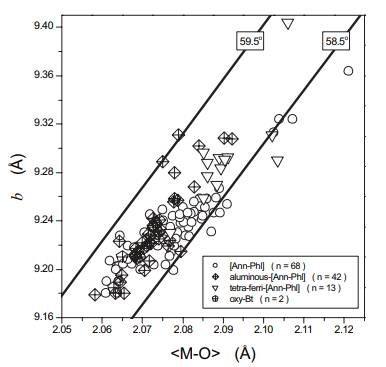
Patrick H.J. Mercier; Denis G. Rancourt; Guenther J. Redhammer; André E. Lalonde; Jean-Louis Robert; Rob G. Berman; Hideomi Kodama
American Mineralogist (2006) 91 (5-6): 831–849. https://doi.org/10.2138/am.2006.1815
Abstract
We have used recently developed quantitative crystal chemical models and a simple structural free-energy model to examine and interpret: (1) previously reported powder X-ray diffraction data for several trioctahedral mica solid solution series (64 synthetic powder samples between the Mg, Co, Ni, and Fe end-members, with different degrees of oxidation, vacancy contents, and Al/Si ratios; indexed as 1M polytype, space group C2/m; supplemented here by 57Fe Mössbauer spectroscopy to obtain accurate iron-site populations of IVFe3+, VIFe3+, and VIFe2+), and (2) 175 previously published single-crystal refinements comprising 138 natural and 37 synthetic 1M mica samples refined in space group C2/m. The crystal chemical models were validated by comparisons between predicted and measured relations between structural parameters, and needed model parameters and their uncertainties were extracted, using the single-crystal refinements. Two main results arise. First, an observed limit value of the b lattice parameter in certain synthetic solid solution series is shown to correspond to an upper limit value for the tetrahedral rotation angle α of αmax = 9.5° for AlSi3 tetrahedral sheets in K-rich micas. This upper limit is also clearly seen in the single-crystal refinement data for those K-rich single-crystals that have near-AlSi3 tetrahedral compositions. We argue that the (tetrahedral sheet composition dependent) upper limit of tetrahedral rotation is an intrinsic property of the tetrahedral sheet (presumably corresponding to an intra-tetrahedral-sheet bond-bending limit) rather than arising either from interactions with the interlayer cations or from an octahedral sheet lateral-contraction limit. Second, we find that, except in the extreme cases where one approaches the lower (α = 0°) or upper (α = αmax) tetrahedral rotation limits, the magnitude of the octahedral flattening angle ψ is predominantly determined by octahedral cation stereo-chemical bonding requirements (and other intra-octahedral-sheet properties such as intra-sheet bond bending and intra-sheet electrostatic forces) rather than arising from tetrahedral-octahedral inter-sheet interactions (as generally argued or assumed). In addition, we corroborate a previously reported difference in the crystal chemical behaviors of trivalent octahedral cation (Fe3+, Al3+) and vacancy-bearing trioctahedral micas relative to samples that contain only divalent octahedral cations (e.g., Fe-Mg, Fe-Ni, Mg-Ni, and Co-Mg synthetic series); their b vs. average octahedral metal-oxygen bond-length behaviors are dramatically different, a result that is consistent with our proposed dominant stereo-chemical control of ψ.